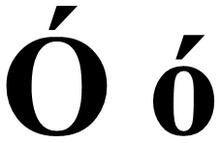 | ||
Ó, ó (o-acute) is a letter in the Emilian-Romagnol, Faroese, Hungarian, Icelandic, Kashubian, Polish, Czech, Slovak, and Sorbian languages. This letter also appears in the Afrikaans, Catalan, Irish, Occitan, Portuguese, Spanish, Italian and Galician languages as a variant of letter “o”. It is sometimes also used in English for loanwords.
Contents
Spanish
Used for loanwords like periódico, peón, piñón or bodegón (Spanish).
Chinese
In Chinese pinyin ó is the yángpíng tone (阳平, high-rising tone) of "o".
Czech and Slovak
Ó is the 24th letter of the Czech alphabet and the 28th letter of the Slovak alphabet. It represents /oː/.
Emilian-Romagnol
In Emilian, ó is used to represent [o], e.g. sótt [sotː] "dry". In Romagnol, ó is used to represent [oː], e.g. alóra [aˈloːra] "then".
Faroese
Ó is the 18th letter of the Faroese alphabet and represents /œ/ or /ɔuː/.
Icelandic
Ó is the 19th letter of the Icelandic alphabet and represents /oṷ/.
Irish
Ó is widely used in Irish where it has various meanings:
Italian
In Italian, ó is an optional symbol (especially used in dictionaries) sometimes used to indicate that a stressed o should be pronounced with a close sound: córso [ˈkorso], "course", as opposed to còrso [ˈkɔrso], "Corsican" (but both are commonly written with no accent marks when the context is clear). A similar process may occur with é and è, as in pésca, "fishing", and pèsca "peach".
Kashubian
Ó is the 23rd letter of the Kashubian alphabet and represents /o/. It also represents /u/ in southern dialects.
Hungarian
Ó is the 25th letter of the Hungarian alphabet. It represents /oː/.
Polish
Ó is the 21st letter of the Polish alphabet, and represents /u/.
Portuguese
In Portuguese, ó is used to mark a stressed /ɔ/ in words whose stressed syllable is in an unpredictable location within the word, as in "pó" (dust) and "óculos" (glasses). If the location of the stressed syllable is predictable, the acute accent is not used. Ó /ɔ/ contrasts with ô /o/.
Scottish Gaelic
Ó was once widely used in Scottish, but it has now been largely superseded by "ò". It can still be seen in certain writings but is no longer used in standard orthography.
Spanish
Ó is used in the Spanish language to denote an 'o' syllable with abnormal stress.
Sorbian
Ó represents /uʊ/ in Upper Sorbian and represents /ɛ/ or /ɨ/ in, especially, Lower Sorbian.
Vietnamese
In Vietnamese alphabet ó is the sắc tone (high-rising tone) of “o”.
